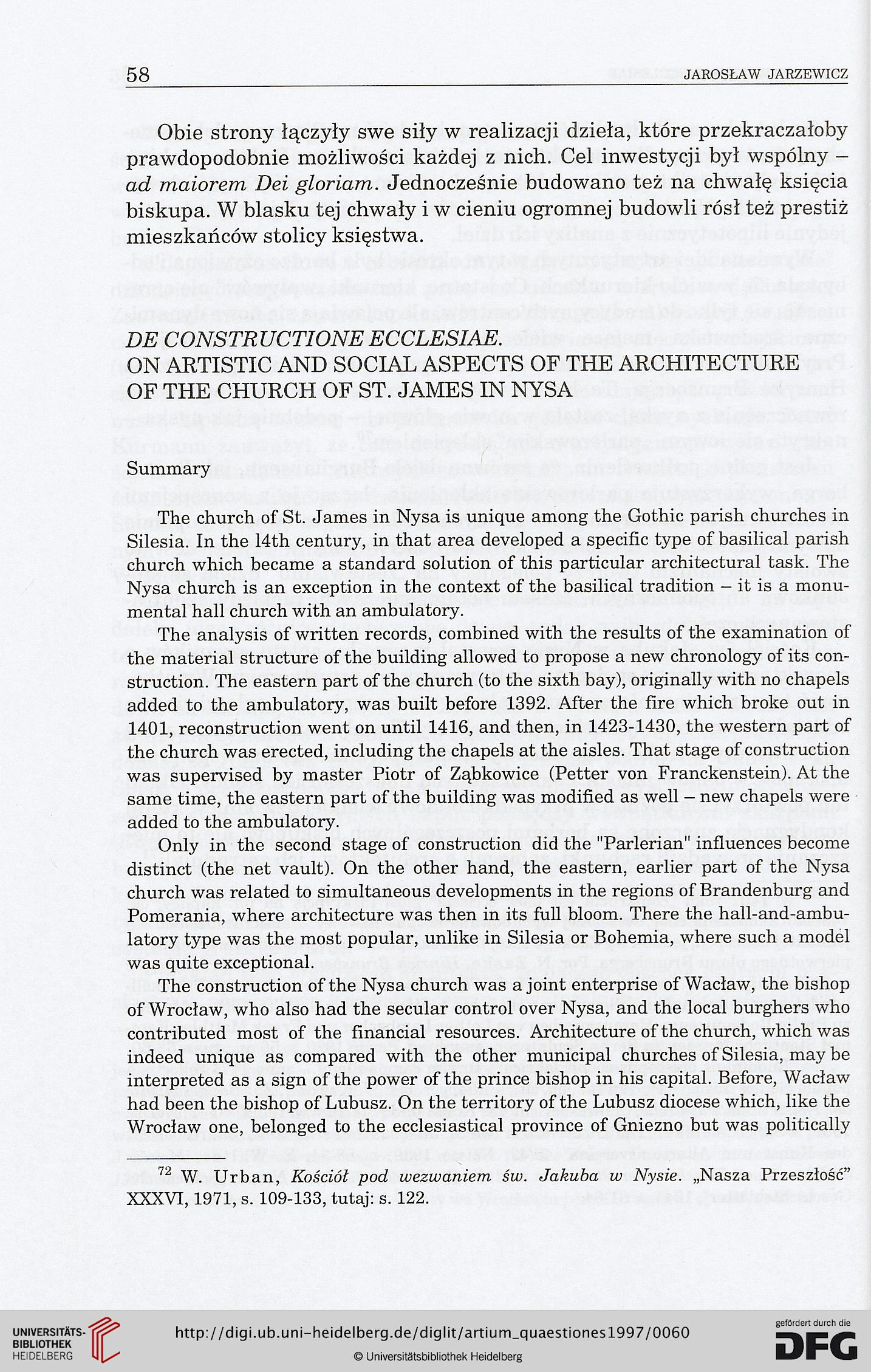58
JAROSŁAW JARZEWICZ
Obie strony łączyły swe siły w realizacji dzieła, które przekraczałoby
prawdopodobnie możliwości każdej z nich. Cel inwestycji był wspólny -
ad maiorem Dei gloriam. Jednocześnie budowano też na chwałę księcia
biskupa. W blasku tej chwały i w cieniu ogromnej budowli rósł też prestiż
mieszkańców stolicy księstwa.
DE CONSTRUCTIONE ECCLESIAE.
ON ARTISTIC AND SOCIAL ASPECTS OF THE ARCHITECTURE
OF THE CHURCH OF ST. JAMES IN NYSA
Summary
The church of St. James in Nysa is uniąue among the Gothic parish churches in
Silesia. In the 14th century, in that area developed a specific type of basilical parish
church which became a standard solution of this particular architectural task. The
Nysa church is an exception in the context of the basilical tradition — it is a monu-
mental hall church with an ambulatory.
The analysis of written records, combined with the results of the examination of
the materiał structure of the building allowed to propose a new chronology of its con-
struction. The eastern part of the church (to the sixth bay), originally with no chapels
added to the ambulatory, was built before 1392. After the fire which broke out in
1401, reconstruction went on until 1416, and then, in 1423-1430, the western part of
the church was erected, including the chapels at the aisles. That stage of construction
was supervised by master Piotr of Ząbkowice (Petter von Franckenstein). At the
same time, the eastern part of the building was modified as well - new chapels were
added to the ambulatory.
Only in the second stage of construction did the "Parlerian" influences become
distinct (the net vault). On the other hand, the eastern, earlier part of the Nysa
church was related to simultaneous developments in the regions of Brandenburg and
Pomerania, where architecture was then in its fuli bloom. There the hall-and-ambu-
latory type was the most popular, unlike in Silesia or Bohemia, where such a model
was ąuite exceptional.
The construction of the Nysa church was a joint enterprise of Wacław, the bishop
of Wrocław, who also had the secular control over Nysa, and the local burghers who
contributed most of the financial resources. Architecture of the church, which was
indeed uniąue as compared with the other municipal churches of Silesia, may be
interpreted as a sign of the power of the prince bishop in his capital. Before, Wacław
had been the bishop of Lubusz. On the territory of the Lubusz diocese which, like the
Wrocław one, belonged to the ecclesiastical province of Gniezno but was politically
72 W. Urban, Kościół pod wezwaniem św. Jakuba w Nysie. „Nasza Przeszłość”
XXXVI, 1971, s. 109-133, tutaj: s. 122.
JAROSŁAW JARZEWICZ
Obie strony łączyły swe siły w realizacji dzieła, które przekraczałoby
prawdopodobnie możliwości każdej z nich. Cel inwestycji był wspólny -
ad maiorem Dei gloriam. Jednocześnie budowano też na chwałę księcia
biskupa. W blasku tej chwały i w cieniu ogromnej budowli rósł też prestiż
mieszkańców stolicy księstwa.
DE CONSTRUCTIONE ECCLESIAE.
ON ARTISTIC AND SOCIAL ASPECTS OF THE ARCHITECTURE
OF THE CHURCH OF ST. JAMES IN NYSA
Summary
The church of St. James in Nysa is uniąue among the Gothic parish churches in
Silesia. In the 14th century, in that area developed a specific type of basilical parish
church which became a standard solution of this particular architectural task. The
Nysa church is an exception in the context of the basilical tradition — it is a monu-
mental hall church with an ambulatory.
The analysis of written records, combined with the results of the examination of
the materiał structure of the building allowed to propose a new chronology of its con-
struction. The eastern part of the church (to the sixth bay), originally with no chapels
added to the ambulatory, was built before 1392. After the fire which broke out in
1401, reconstruction went on until 1416, and then, in 1423-1430, the western part of
the church was erected, including the chapels at the aisles. That stage of construction
was supervised by master Piotr of Ząbkowice (Petter von Franckenstein). At the
same time, the eastern part of the building was modified as well - new chapels were
added to the ambulatory.
Only in the second stage of construction did the "Parlerian" influences become
distinct (the net vault). On the other hand, the eastern, earlier part of the Nysa
church was related to simultaneous developments in the regions of Brandenburg and
Pomerania, where architecture was then in its fuli bloom. There the hall-and-ambu-
latory type was the most popular, unlike in Silesia or Bohemia, where such a model
was ąuite exceptional.
The construction of the Nysa church was a joint enterprise of Wacław, the bishop
of Wrocław, who also had the secular control over Nysa, and the local burghers who
contributed most of the financial resources. Architecture of the church, which was
indeed uniąue as compared with the other municipal churches of Silesia, may be
interpreted as a sign of the power of the prince bishop in his capital. Before, Wacław
had been the bishop of Lubusz. On the territory of the Lubusz diocese which, like the
Wrocław one, belonged to the ecclesiastical province of Gniezno but was politically
72 W. Urban, Kościół pod wezwaniem św. Jakuba w Nysie. „Nasza Przeszłość”
XXXVI, 1971, s. 109-133, tutaj: s. 122.




